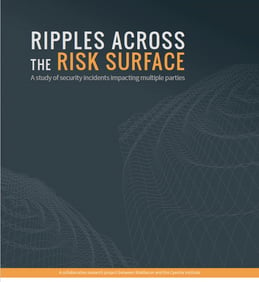New Report: Ripples Across the Risk Surface
A study of security incidents impacting multiple parties
Report Overview

Cyentia Institute and RiskRecon analyzed over 800 multi-party cyber incidents to determine the impact on multiple downstream organizations. This first-of-its-kind report analyzes the ripple effect of multi-party vs. single-party security incidents, the results show that financial losses of multi-party cyber-incidents are 13x greater vs single-party events.
Key findings:
- The average ripple event impacts 10 firms beyond the original victim
- The largest ripple event touched 131 firms downstream
- Ripple events are growing more common, increasing on average by 20% annually
Download the report and take a cruise through our interactive graphic to see the interconnected relationships that spider across industries and information transactions.
Follow us for the latest insights





